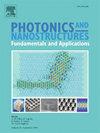Exploring the interaction between bloch surface waves and atomic hot vapor: a theoretical perspective
IF 2.9
3区 物理与天体物理
Q3 MATERIALS SCIENCE, MULTIDISCIPLINARY
Photonics and Nanostructures-Fundamentals and Applications
Pub Date : 2025-07-20
DOI:10.1016/j.photonics.2025.101429
引用次数: 0
Abstract
The miniaturization of atom-light interaction platforms is crucial for advancing modern optical technologies, enabling significant improvements in sensing, communication, and quantum information processing. In this paper, we present a theoretical investigation into the coupling of Bloch surface waves (BSWs) at the resonance angle of 69° in a one-dimensional 24-layered photonic crystals with atomic hot vapor with a focus on atomic structures. These surface waves are known for their strong field confinement and high sensitivity to environmental changes which offer a promising avenue for enhancing light-matter interactions at reduced scales. Our findings highlight the potential of Bloch surface waves to enhance and control the localized density of states (LDOS), thereby improving the resolution of atomic transition lines. Notably, our simulations demonstrate that BSWs achieve superior resolution compared to plasmonic modes, enabling the distinct resolution of all eight hyperfine states of natural rubidium vapor (four for 85Rb and four for 87Rb D1 line). This study underscores the importance of integrating Bloch surface waves with atomic hot vapor for developing next-generation miniaturized optical devices, which can lead to breakthroughs in precision metrology, high-resolution spectroscopy, and quantum technologies.
探索斑点表面波与原子热蒸汽之间的相互作用:一个理论视角
原子-光相互作用平台的小型化对于推进现代光学技术至关重要,能够在传感、通信和量子信息处理方面取得重大进展。本文对一维24层原子热蒸汽光子晶体中布洛赫表面波(BSWs)在69°共振角下的耦合进行了理论研究,重点研究了原子结构。这些表面波以其强场约束和对环境变化的高灵敏度而闻名,这为在小尺度上增强光-物质相互作用提供了一条有希望的途径。我们的发现强调了布洛赫表面波增强和控制局域态密度(LDOS)的潜力,从而提高了原子跃迁线的分辨率。值得注意的是,我们的模拟表明,与等离子体模式相比,bsw实现了更高的分辨率,能够实现天然铷蒸气的所有八种超精细状态(85Rb和87Rb D1线的四种)的不同分辨率。这项研究强调了将布洛赫表面波与原子热蒸汽相结合对于开发下一代小型化光学器件的重要性,这将导致精密计量、高分辨率光谱学和量子技术的突破。
本文章由计算机程序翻译,如有差异,请以英文原文为准。
求助全文
约1分钟内获得全文
求助全文
来源期刊
CiteScore
5.00
自引率
3.70%
发文量
77
审稿时长
62 days
期刊介绍:
This journal establishes a dedicated channel for physicists, material scientists, chemists, engineers and computer scientists who are interested in photonics and nanostructures, and especially in research related to photonic crystals, photonic band gaps and metamaterials. The Journal sheds light on the latest developments in this growing field of science that will see the emergence of faster telecommunications and ultimately computers that use light instead of electrons to connect components.

 求助内容:
求助内容: 应助结果提醒方式:
应助结果提醒方式:


